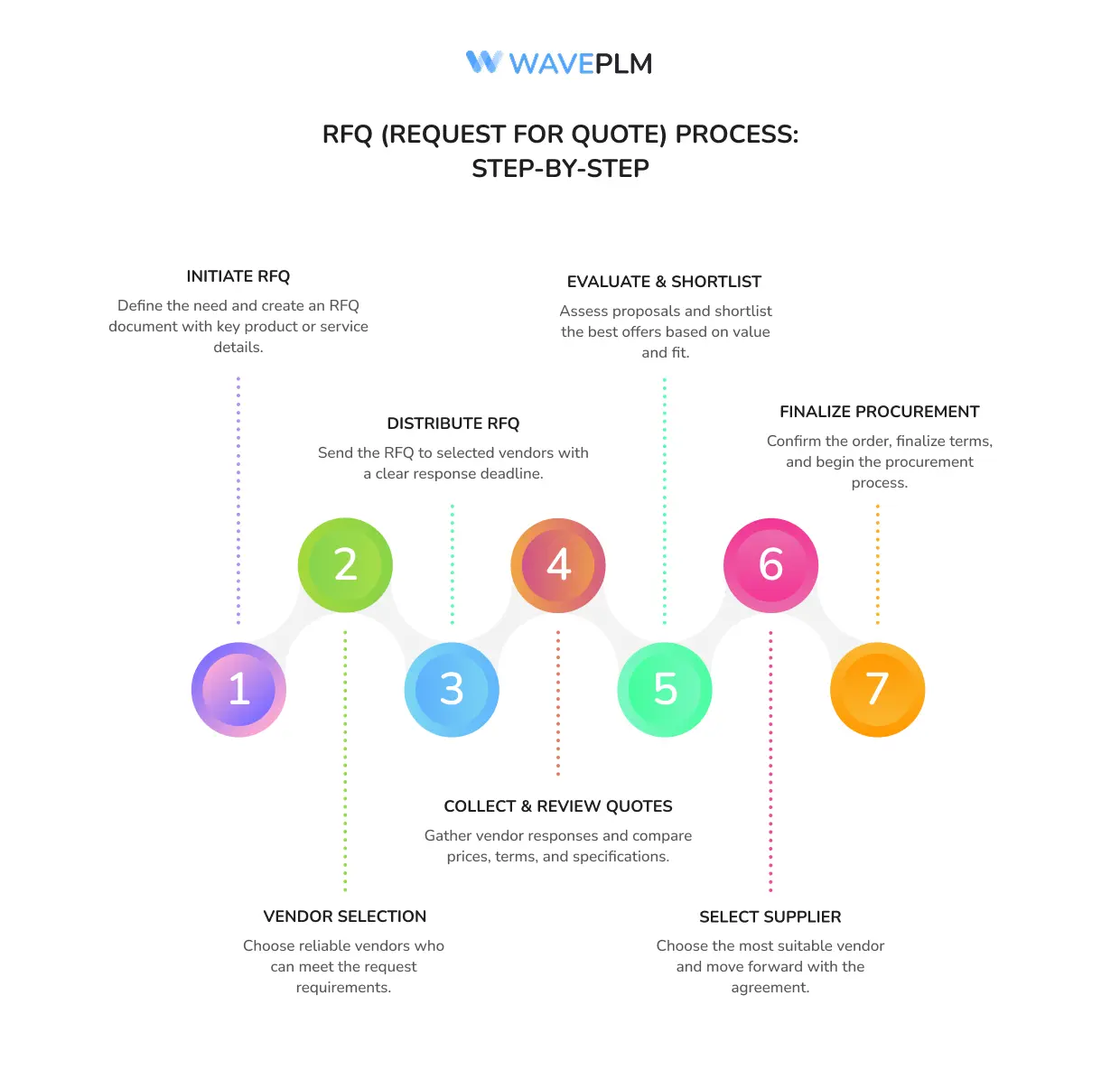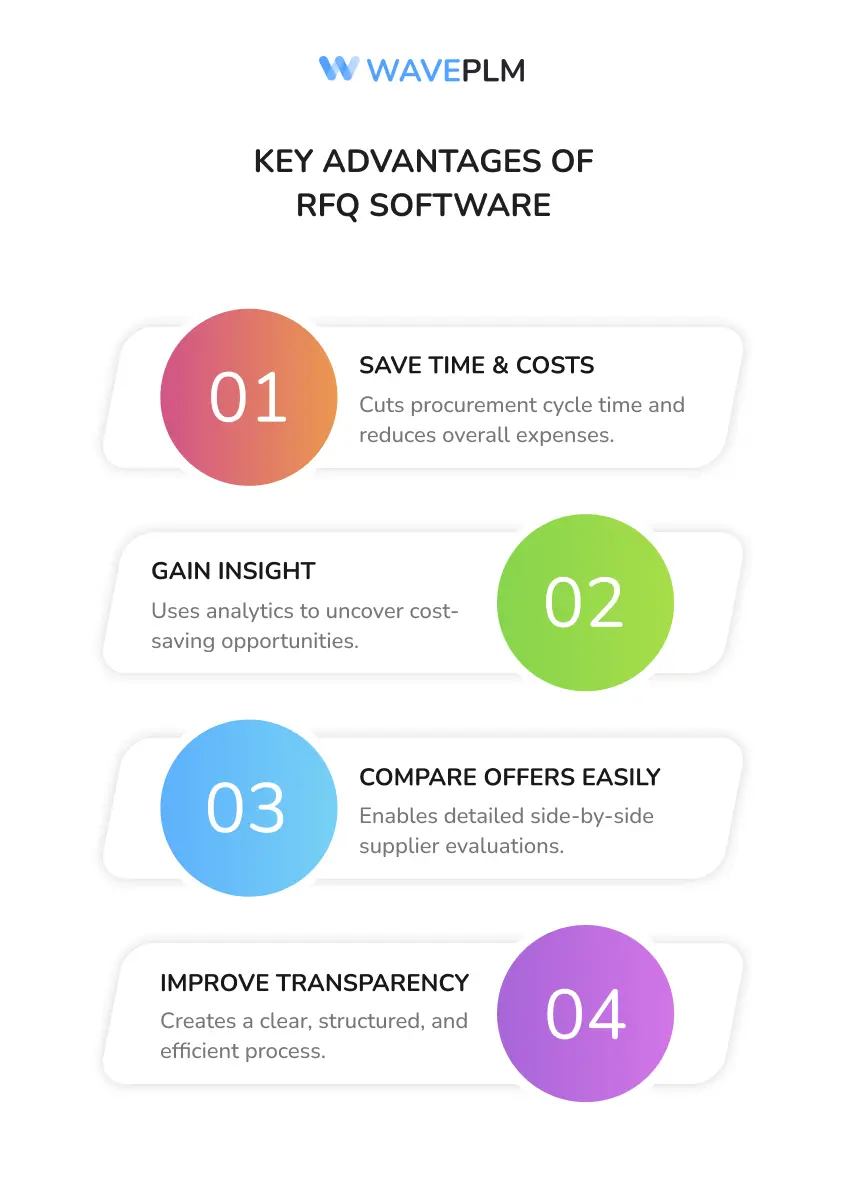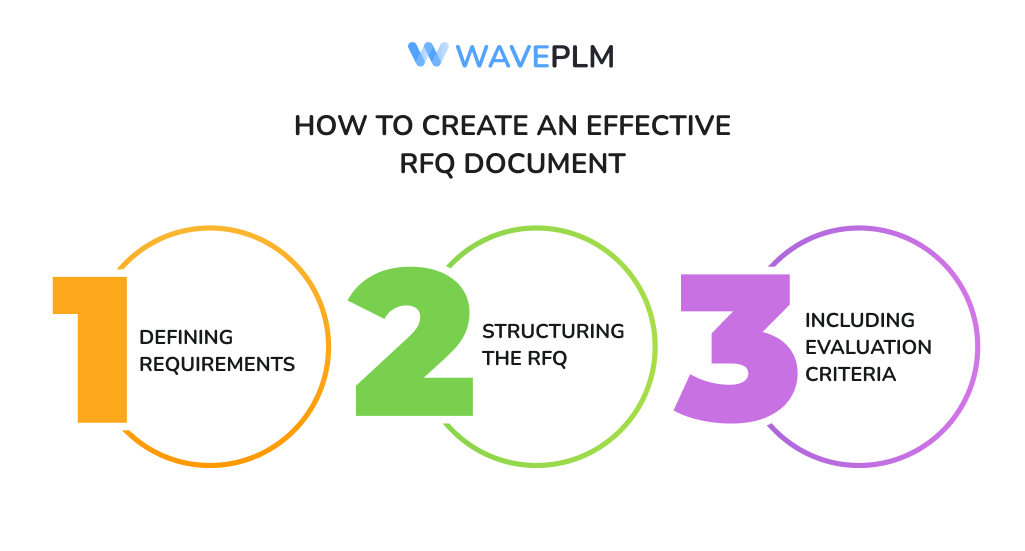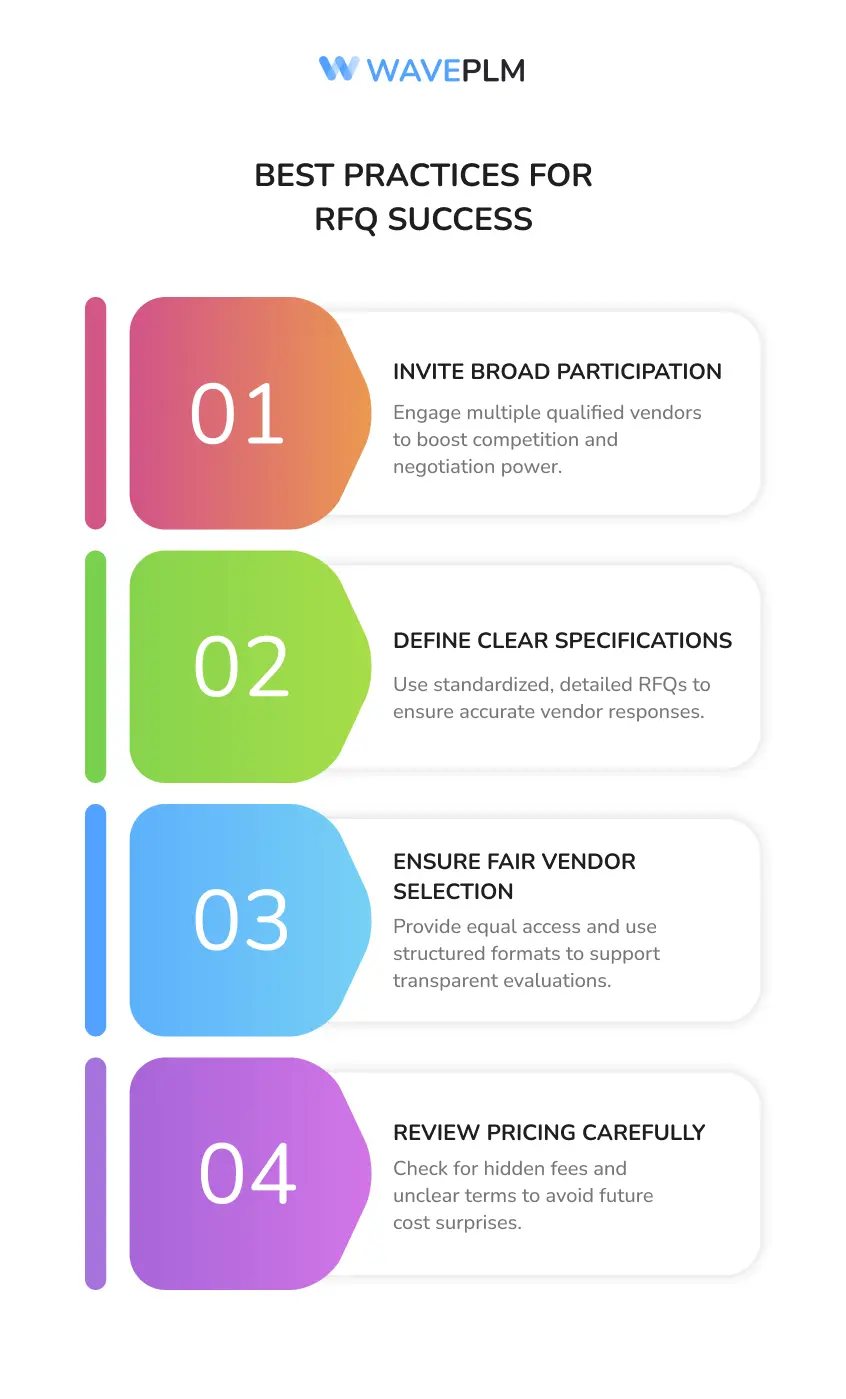
An RFQ, or Request for Quote, is a tool businesses use to gather pricing information from suppliers for specific products or services. It’s essential for ensuring competitive pricing and a reliable supply chain. In this article, you’ll learn what an RFQ involves, why it’s crucial, and how to master the RFQ process.
Key Takeaways
- An RFQ (Request for Quote) is a formal document used to solicit pricing from suppliers, ensuring competitive pricing and quality, especially in public procurement.
- The RFQ process involves six systematic steps, including document preparation, supplier selection, and evaluation, to enhance procurement efficiency and transparency.
- Effective RFQs must include clear project specifications, detailed evaluation criteria, and foster fairness in vendor selection to achieve successful procurement outcomes.
Understanding RFQ (Request for Quote)

A Request for Quote (RFQ) is a formal process used to solicit price quotes from selected suppliers for specific tasks or projects. Businesses deploy RFQs to obtain pricing quickly and consistently, ensuring a reliable supply of standard products or services. This document is typically sent to trusted vendors to gather detailed pricing information, including supplier costs, payment terms, and product specifications. Understanding rfq meaning is essential for effective procurement. A requested request for quotation rfq is an important part of this process, as it often includes multiple requests.
RFQs are invaluable across various industries, particularly in public procurement, where comparing quotes from multiple vendors ensures competitive pricing and quality. RFQs enable organizations to choose the best partner for standardized products or services by concentrating on price, particularly when quantities are consistent and repetitive. An RFQ reduces the complexity of the selection process.
RFQ vs RFP: Key Differences
Understanding the difference between an RFQ and an RFP is crucial for effective procurement. An RFQ seeks specific pricing information for known products or services, making it ideal for straightforward purchases where price is the primary concern. In contrast, a Request for Proposal (RFP) solicits detailed proposals for complex projects, requiring innovative solutions beyond just pricing.
While RFQs are typically shorter and more focused, RFPs cover various aspects of a project, including technical and strategic elements. Businesses might incorporate RFQs in the initial stages of the RFP process if price is a critical differentiator. This layered approach ensures comprehensive evaluation and optimal vendor selection.
The RFQ Process Explained
The RFQ process is a systematic approach that can significantly enhance procurement efficiency. Typically, it involves six key steps:
- Document preparation
- Defining the supplier list
- Sending out the RFQ
- Receiving responses
- Selecting the successful supplier
- Notifying unsuccessful bidders.
This structured business process enables buyers to connect with specialized suppliers, ensuring a seamless sourcing experience.
Preparation Phase
The preparation phase is the cornerstone of a successful RFQ process. A well-prepared RFQ document should include:
- Detailed specifications of the required products or services
- Delivery deadlines
- Payment terms
- Evaluation methods Incorporating stakeholder feedback at this stage enhances the quality of the RFQ, ensuring that all project requirements and risks are adequately addressed.
Determining financial parameters, including budget limitations, is critical. The RFQ must outline:
- The project’s scope
- Quantities
- Payment terms
- Delivery dates A clear timeline helps vendors determine if they can meet project deadlines, and explicit submission instructions prevent confusion.
Also, deciding on the type of bid and approach to suppliers based on project needs is vital. This strategic planning sets the stage for a transparent and efficient RFQ process, paving the way for accurate and competitive bids.
Sending Out the RFQ
After preparing the RFQ document, follow these steps:
- Distribute it to selected vendors.
- Provide bidders with clear submission instructions, including a due date and the buyer’s terms.
- Ensure all bidders receive the same information to maintain a fair and competitive bidding environment.
- Include a point of contact for vendors to facilitate smooth communication throughout the process.
Timing is crucial when sending out an RFQ. Vendors need adequate time to prepare responses, so avoid setting inconsistent or unclear submission deadline that could lead to rushed or delayed submissions. Depending on the urgency, RFQs can be sent via email or direct mail.
After sending the RFQ, the procurement team waits for responses to start the evaluation process.
Receiving and Evaluating Responses
Receiving and evaluating responses is a critical phase that demands fairness and confidentiality. All vendors must have equal access to information, and confidentiality must be maintained to uphold the evaluation process’s integrity. Documenting all actions, such as bids received, evaluation criteria, and informed decisions, ensures transparency.
When managing vendor evaluations, consider the following steps:
- Acknowledge every response from vendors and update the evaluation team promptly.
- Pre-qualify vendors based on specific criteria to streamline the evaluation by quickly filtering out unsuitable candidates.
- When selecting a vendor, consider both the price and the supplier’s ability to deliver the required service.
After choosing a chosen vendor, follow these steps:
- Clarify and negotiate details such as deliverables, timeframes, and pricing with qualified contractors and potential supplier.
- Inform unsuccessful suppliers, expressing gratitude for their participation.
- Secure a signed binding contract with the selected vendor before notifying others.
Importance of Using RFQs
RFQs are instrumental in fostering a competitive environment that can lead to significant cost savings. Automated RFQ software offers several advantages:
- Drastically cuts down procurement cycle time and costs
- Provides advanced reporting and analytics to spot cost-saving opportunities
- Allows for detailed comparisons of supplier offerings
- Ensures transparency and efficiency through a structured approach.
Clearly outlining project requirements and specifications in RFQs minimizes misunderstandings between buyers and suppliers. This direct communication supports transparent relationships and encourages competitive quotes from vendors, ultimately leading to better procurement outcomes.

How to Create an Effective RFQ Document
An effective RFQ document is foundational for a successful procurement process. Key elements include:
- Clear objectives and evaluation criteria to avoid irrelevant responses.
- Early stakeholder engagement.
- Providing adequate information to ensure comprehensive and accurate bids.
A well-structured RFQ should outline the company’s business needs, allowing suppliers to present their business document offers effectively through public solicitation.
Defining Requirements
Defining the specific project requirements is a critical step. Full specifications, including technical and commercial requirements, must be clearly outlined. Before drafting the RFQ, it is essential to define the services required, project scope, and preliminary budget.
A method for questions and answers during the bid preparation period ensures clarity and facilitates accurate supplier bids.
Structuring the RFQ
A well-organized RFQ document enhances clarity and facilitates easier comparison of supplier proposals. Organizing the RFQ into clear sections helps in navigation, such as:
- Project details
- Vendor information
- Submission requirements Standardizing specifications and incorporating a structured template can significantly simplify the evaluation process.
Including details such as quantities, cost breakdown, pricing, volume discounts, and total price ensures a more comprehensive price quote. This organized approach promotes transparency and efficiency in the RFQ process.
Including Evaluation Criteria
Including specific evaluation criteria in an RFQ document is crucial for standardizing the assessment process. Establishing transparent qualifying criteria like price, delivery time, and vendor experience ensures a fair and objective evaluation of all bids.
Clear criteria help vendors understand how their proposals will be judged, guiding them to provide more accurate and relevant information. This transparency fosters trust and encourages vendors to submit competitive and thorough bids.

Best Practices for RFQ Success
Achieving success in the RFQ process requires adherence to certain best value practices. Inviting a variety of potential suppliers and other bidders to submit bids solicits bids gives buyers a strong position for negotiation, leading to potential better deals, ultimately resulting in the company’s bid selection of a successful bidder.
Streamlining and enhancing the accuracy of RFQ processes is essential for effective procurement outcomes.
Clear and Detailed Specifications
Providing clear and detailed specifications in an RFQ increases the likelihood of receiving accurate quotes from vendors. A well-structured RFQ should outline the necessary products or services, along with commercial requirements and submission guidelines. A standardized document format makes it easier to compare prices and expertise among vendors.
Comprehensive project specifications help vendors understand the requirements fully, which leads to more precise quotes. This clarity reduces misunderstandings and ensures all vendors are aligned, even when lengthy documentation is involved.
Fair Vendor Selection
Ensuring fairness in vendor selection is paramount. Key principles include:
- Providing equal access to data and documents to foster transparency and fairness among all vendors.
- Avoiding manipulation of the list of bidders.
- Not restricting competition to ensure a fair selection process.
Using standardized formats for RFQs and well-structured templates aids in the easy evaluation of bids, making life easier. This fairness ensures that all suppliers have an equal opportunity to compete for contracts, fostering a trustworthy procurement environment.
Checking Pricing Structures
Reviewing vendor pricing structures helps avoid unexpected costs. Always verify hidden fees and contract terms to ensure transparency. Accepting the best price from a supplier can lead to vague contract terms that may result in higher costs later.
Carefully reviewing vendor quotes helps in identifying any potential pitfalls and ensures that the procurement team is fully aware of all costs involved.

Common Mistakes to Avoid in the RFQ Process
Avoiding common mistakes in the RFQ process is crucial for successful procurement. Using overly complicated or vague language can confuse suppliers and result in misinterpretations or incomplete proposals. Neglecting to allow for flexibility or negotiation can prevent leveraging better value or innovative solutions from suppliers.
Digital Tools for RFQ Management
Digital tools can significantly streamline the RFQ process and reduce manual effort. Centralized vendor management tools allow organizations to maintain a complete database of vendor information and compliance documents. Real-time collaboration features within RFQ management software can streamline communication with vendors, reducing email clutter.
Effective RFQ software like Wave PLM should feature easy RFQ creation using templates and automated workflows. Integration with existing software ecosystems, such as Microsoft 365, enhances functionality and user experience, making the entire procurement process more efficient.
Real-World Examples of RFQs
RFQs serve as a formal request used across multiple industries to gather price quotes and specifications from suppliers. For instance, in the construction industry, a company may issue an RFQ for materials such as concrete or steel to ensure the best pricing and quality for a new project.
In the technology sector, companies often send out RFQs for software solutions, allowing various vendors to submit proposals with their offerings. Similarly, the healthcare industry utilizes RFQs to procure medical supplies, ensuring competitive bidding among suppliers for essential items.
Summary
Mastering the RFQ process is vital for any organization looking to streamline its procurement activities and achieve cost savings. By understanding the nuances of RFQs and implementing best practices, companies can ensure they receive accurate, competitive bids that meet their specific needs.
RFQs foster transparency, efficiency, and strong vendor relationships, making them an indispensable tool in the procurement toolkit. Embracing digital tools and maintaining clear communication throughout the RFQ process will further enhance procurement outcomes, driving success and growth for your organization.
Frequently Asked Questions
What is an RFQ?
An RFQ, or Request for Quote, is a formal document sent to suppliers to obtain price estimates for specific projects or tasks, mainly for standardized products or services. It serves as a crucial tool for businesses to compare costs and make informed purchasing decisions.
How does an RFQ differ from an RFP?
An RFQ is primarily concerned with gathering pricing details for specified products or services, whereas an RFP seeks comprehensive proposals for more complex projects that demand innovative approaches.
What are the key steps in the RFQ process?
The RFQ process consists of six essential steps: preparing the RFQ document, defining the supplier list, distributing the RFQ, collecting responses, selecting the winning supplier, and informing unsuccessful bidders. Following these steps ensures an organized and efficient procurement process.
Why is it important to use RFQs?
It is important to use RFQs because they create a competitive environment that promotes cost savings and efficient procurement while enabling detailed comparisons of supplier offerings, which fosters transparency in buyer-supplier relationships.
What digital tools can help manage the RFQ process?
Utilizing centralized vendor management systems and RFQ management software can significantly streamline the RFQ process, minimize manual tasks, and improve vendor communication. Implementing these tools will enhance overall efficiency and effectiveness in managing RFQs.





Leave a Reply